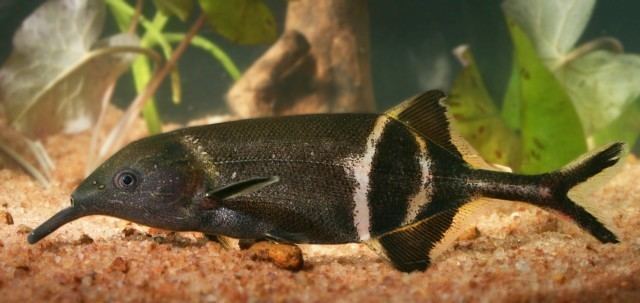Scientific name Gnathonemus petersii Rank Species | ||
Similar Gnathonemus, Mormyridae, Black ghost knifefish, Freshwater butterflyfish, Mormyrus | ||
Peters' elephant-nose fish (Gnathonemus petersii; syn. Gnathonemus brevicaudatus Pellegrin, 1919, Mormyrus petersii Günther, 1862) is an African freshwater elephantfish in the genus Gnathonemus. Other names in English include elephantnose fish, long-nosed elephant fish, and Ubangi mormyrid, after the Ubangi River. As the Latin name petersii confirms it is named after someone called "Peters" (probably Wilhelm Peters), although the apostrophe is often misplaced and the common name given as "Peter's elephantnose fish". It uses electrolocation to find prey, and has the largest brain-to-body oxygen use ratio of all known vertebrates (around 0.6).
Contents

Description

Peters' elephantnose fish are native to the rivers of West and Central Africa, in particular the lower Niger River basin, the Ogun River basin and in the upper Chari River. It prefers muddy, slowly moving rivers and pools with cover such as submerged branches. It is a dark brown to black in colour, laterally compressed (averaging 23–25 cm), with a rear dorsal fin and anal fin of the same length. Its caudal or tail fin is forked. It has two stripes on its lower pendicular. Its most striking feature, as its names suggest, is a trunk-like protrusion on the head. This is not actually a nose, but a sensitive extension of the mouth, that it uses for self-defense, communication, navigation, and finding worms and insects to eat. This organ is covered in electroreceptors, as is much of the rest of its body. The elephantnose uses a weak electric field, which it generates with specialized cells called electrocytes, which evolved from muscle cells, to find food, to navigate in dark or turbid waters, and to find a mate. Peters' elephantnose fish live to about 6–10 years, but there are reports of them living even longer.
In the aquarium

Peters' elephantnose fish is among the most commonly available Mormyrid in aquarium stores in the USA. In the aquarium it is timid, preferring a heavily planted environment with subdued lighting and thrives in a tank of more than 200 liters. Ideally, a pipe or hollow log should be provided and the optimum substrate is some soft sand that allows the fish to sift through it with its delicate extended lip. It feeds on small worms(bloodworms being the most common) and aquatic invertebrates such as mosquito larvae, but in the aquarium will accept frozen or flake food. How peaceful an elephantnose fish is can depend on the individual; some are quite aggressive with other species, while others are retiring. They may be kept in a community aquarium with peaceful species who share their water preferences. However, unless kept in an aquarium of over 400 liters, it is unwise to keep more than one elephantnose fish as they can be territorial. The elephantnose is suggested to be kept in the following conditions: pH of 6.8 to 7.2, water temperature 26C to 28C, and water of medium hardness.
The weak electrical impulses generated by this fish can be made audible by placing two electrodes in the fish tank that are then hooked up to an audio amplifier or a piezoelectric earbud. The elephant nose fish can use its electosensing to detect moving prey and worms in the substrate.
Although the elephant nose fish was once thought to have poor eyesight, it is now known to have good low light vision. Its eyes use a combination of photonic crystals, parabolic mirrors and a clustered arrangement of rods and cones.
